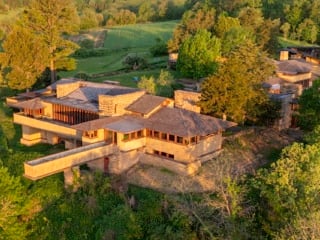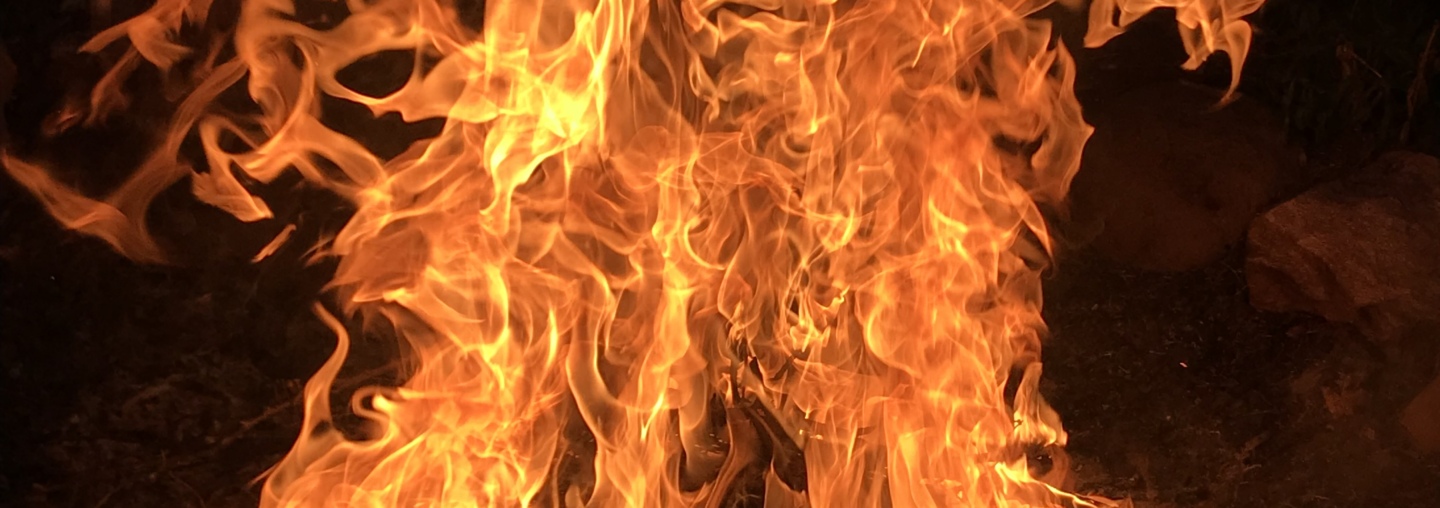
Willey House Stories Part 22: Calling the Kettle Back—Chapter 6: Transcendental Flame
Steve Sikora | Feb 10, 2023
In this seven-chapter subseries of the Willey House Stories, Steve Sikora reflects on Frank Lloyd Wright’s fireplaces, their purpose, and meaning—and the search for one missing kettle. You can read the previous chapters to date by clicking on the links at the bottom of this post.
In case it is not obvious by now, following the trail of the lost Willey House kettle, I took a tumble down the rabbit hole of Wright’s fireplaces and their meaning. In my long deliberations, I came to understand the nuts and bolts particulars of his remarkable hearths. But in this next chapter, I endeavor to explain the whys and wherefores of the greater purpose behind their design.
The fireplace: a portal
Understood to be providers of creature comforts and aesthetic pleasures, Frank Lloyd Wright’s fireplaces represent a greater ambition too, one less tangible, but no less essential—that being his desire to reconnect man with deeper capital “N” Nature. The fire ablaze at the heart of his houses is symbolic of the life he breathed into the “organisms” of his living architecture, as he called them.
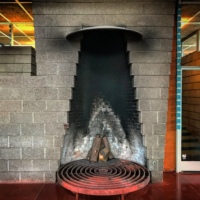
The left edge of the stepped negative space of the Harold Price Sr. fireplace shows a remnant of what was once a crane and concave bowl-shaped firebasket. Credit: Steve Sikora
Usually placed at its center, a substantial fireplace is the metaphorical and indispensable throbbing heart of a Wright house. This explains his inclusion of a fireplace in every commission, no matter how humble. Even Wright understood no entity could exist without a heart. The heart regulates and sustains the body and what’s more, the heart is the seat of the soul.
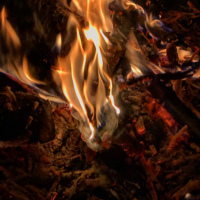
No entity can exist without a heart. Credit: Steve Sikora
To light a fire in the hearth of one’s home is an evocation of primal impulses, predating human history. A raging fire is, to be sure, a thrilling affair—a wild thing barely containable. Its flicking tongues of light present simultaneously as fluid and sharp, vivacious and threatening, startlingly gorgeous and horrifically perilous. To approach a force of nature, such as this, is captivating in and of itself. But to tame such wildness is a supremely powerful act. Man’s ability to manipulate fire reinforces his mastery over his domain and by extension, affirms his inclusion in it. Wright’s use of the fireplace is a means to both of those ends.
In the abstract, Frank Lloyd Wright’s fireplaces are elemental. Fire, earth, air, water, the terrestrial elements, are each represented in a fireplace; earth in the masonry, air in the draft, fire in combustion and water to manage or extinguish flame. If you question the inclusion of water, consider the fireplace at Hollyhock, the Aline Barnsdall house in Los Angeles, which is literally surrounded by a mote.
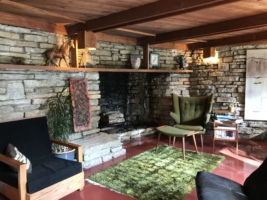
The prehistoric setting of the Jacobs II fireplace. Credit: Steve Sikora
Unlike his architect peers, past and present, satisfied to simply decorate around a properly proportioned hole, Wright’s innovative approach to fireplace design openly scoffs at those mere perpetuators of flue induction, to imagine something audacious, something fully integrated into the architecture of the room, a thing of extraordinary beauty and something profoundly experiential for his clients. He created breathtaking moments in masonry with the highest of aspirations, whether they properly vented smoke or not. Eugene Masselink, acting as Wright’s personal secretary, cautioned Nancy Willey when she asked, “Are you sure the chimney will draw? The contractor doesn’t ‘expect for a moment that it will.’ by saying, “Fireplaces are coquettish.” In other words, they are teasingly difficult to manage and wholly unpredictable, unless of course they are actually designed to function in a calculable manner, which ours are not! (See the specific requirements for a properly functioning fireplace at the end of chapter 3.)
From the midpoint of his career Wright’s fireplaces veered away from the embellished utilitarian, sharply toward the starkly symbolic. As exhilarating as they are to behold, functionality, when it is present, usually, but not always, is a secondary consequence of the design rather than its primary intention.
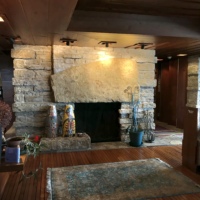
Like several examples of fireplaces in Taliesin, the Pew House fireplace features an immense megalithic lintel. Credit: Steve Sikora
A dichotomy of poetry versus purpose in perpetual tension is characteristic of Wright’s designs. This is particularly evident where his fireplaces are concerned. William Morris advised, “Have nothing in your house that you do not know to be useful, or believe to be beautiful.” But Wright took Morris’ Arts & Crafts dictum further, establishing a sliding scale of balance between the practical and the aesthetic. And occasionally in his work one outweighs the other, for example, when a higher purpose demanded it, as in the dramatically bekettled west fireplace at Wingspread. A favorite quote of Wright’s, found in the Quran and attributed to the prophet Mohammad, expressing the value of beauty in a practical world is emblazoned across a soffit in the sanctuary of Madison’s Unitarian Meeting House. With added punctuation it reads:
“DO YOU HAVE A LOAF OF BREAD? BREAK THE LOAF IN TWO. GIVE HALF FOR SOME FLOWERS OF THE NARCISSUS. FOR THE BREAD FEEDS THE BODY INDEED, BUT THE FLOWERS FEED THE SOUL.”

“…flowers feed the soul.” A favorite quote of Wright’s emblazoned on a soffit inside the Unitarian Meeting House. Credit: Steve Sikora
Wright’s late career fireplaces tipped the scale in favor of flowers to be sure. Aesthetics gained an upper hand over utility. But perhaps the perceived lopsidedness was counterbalanced by a higher purpose. No one would argue that the reason for an automobile is for transportation from point A to point B. However, cars are notoriously experiential. To drive a particular model (say a Gullwing Mercedes 500SL), under the right circumstances (a desolate and curvaceous country road, at the outer limits of traction) can elicit a near-spiritual experience for the driver. In this same way, igniting a blaze in a Wright fireplace can be similarly breathtaking. To be clear, none of this is accidental. Design can be intentionally experiential. The ambition of achieving a transcendent experience may be the entire point of a design. Wright’s apparent penchant for failures in the material world (leaky roofs, sagging cantilevers and now smoking fireplaces), as sacrifices made for the purpose of over-delivering in more subtle, spiritual ways, sounds outlandish at its face but is entirely valid from a design perspective. In the Charles and Ray Eames classic presentation Design Q & A, Charles Eames being interviewed by French curator, Madame L’Amic was asked: “Does Design imply the idea of products that are necessarily useful?” Eames responded with: “Yes, even though the use might be very subtle.” Perhaps Wright’s primary intent was not so much to warm a room but to arouse our unconscious minds from the deep slumber of conformity and the humdrum of fundamental, modern reality.
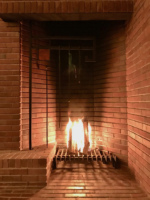
Gloriously exposed open flame inside the Willey House fireplace. Credit: Steve Sikora
As an example, the Willey House fireplace is startlingly uncontained. To make a fire in it is to literally enkindle a conflagration on your living room floor. It’s purely visceral. As I tell tours, “Anyone can have a fire in the middle of their living room floor, once. But here it can be done repeatedly!” Clearly, Wright was as daring in his fireplace designs as he was in his architecture. No surprise then, that Wright frequently tested the limits to the point of failure, pushing aesthetic ideas until the physical plane denied them. Observing the standard parameters for fire safety and draft were secondary to form making and pleasing proportion, as a response to the unit grid. Better to ask forgiveness than permission. Because only by working in this way could he foster such profound connections for his clients with deeper reality outside of their conscious awareness, and to model for them the lives he so wanted them to live. It’s not that Frank Lloyd Wright misunderstood how fireplaces functioned. It’s very likely that thermal efficiency and ability to draw smoke were simply secondary to the truest intent of his work—his creation of a sort of a state of grace in Nature.
What is this capital “N” Nature that Wright so revered? And what did it mean that he wanted us to reclaim it?
Organic architecture creates a literal proximity to the outdoors through open planning and the liberal application of fenestration, among other things. It initiates a figurative proximity to nature with the presence of indigenous, natural building materials. Definitions usually end about there. But also, Wright perceived that life forms thrive in cycles and circadian rhythms. And the human species exhibits emotional and habitual patterns of behavior. He recognized the cadence of these patterns. And he schemed to fit man into his abstract sense of the underlying natural, in the way Froebel tiles lock into a grid. Just as the rhythms of two things as different as movement in the form of dance and the sonic vibrations of music are made to coincide. The tangible and the intangible can be bound together in unity.
Lives are lived in regulated patterns. No accident then that Wright’s houses are imagined and constructed in pattern. With his distinctive approach to organic architecture, Wright manages to superimpose the psycho-spiritual nature of man onto the mathematical nature of the grid. I can’t explain how, but the result is a kind of harmony, like the consonance of a drum beat with that of a human heart, there is an attunement of client to environment. It’s difficult to put it into a conceptual frame, much less into words. But the result is a state of equipoise. Something that comes close to describing it is embodied in the worldview of the Navaho.
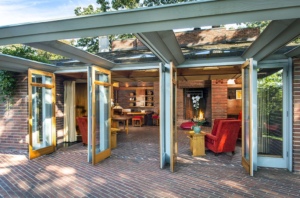
The patterned series of French doors open the living spaces of the Willey House to the outside. Credit: Matt Schmidt
It is the concept of Hózhó, which roughly translates to balance and beauty. Hózhó is considered to be a state of total harmony. According to a particularly eloquent description found on the Indiana University Archeology and Anthropology Department website, “…the concept of Hózhó carries with it an important emphasis on states of harmony. Hózhó also emphasizes the many connections that link the ephemeral and changing parts of the world together into a larger, more persistent, and significant whole.”

Credit: Steve Sikora
In Western culture, beauty is considered a surface phenomenon. But in Navaho culture, beauty “extends beyond what can be perceived by the senses.” Hózhó “encompasses basic ideas about health and goodness.” Hózhó is expressed in orderly and harmonious relationships with other people, beings, and natural forces.
Wright urges us toward a state of harmony with everything—our patterns of living, our relationship with possessions, our exposure to the natural world, our relationships, our movements, even our sense of time. Inherent in that harmony is the overwhelming sense of beauty he opens us to.
The same unit grid that unites all house parts into a harmonious whole is also the one that influences the form of Wright’s fireplaces.
His “subtle purpose” to use Charles Eames’ phraseology may not always fit the conceptual model of a working fireplace. But you now can see why fireplace design is inevitably guided by the grid, rather than standard best practices.
The prerequisite for potential clients, with hopes of establishing a working relationship with Wright, was an open mind. But in order to glean the total effect of the man’s joie de vivre required keeping an open heart as well. Nancy Willey was all in. She began as a dutiful client and matured into a lifelong friend and advocate. The same can be said of the devoted Dr. John Christian. If you have any doubts about the open heart, ask Roland Reisley, who worked with Wright in the early 1950s. He has never fallen out of love with his house and remains steadfast in his regard for the architect who built it.
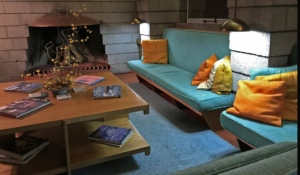
The futuristically primitive fireplace in the Harold Price Sr. living room. Credit: Steve Sikora
Roland will tell you he discovers new beauty in the changing light and perspectives of his beloved home every single day, as he has now for 70 years. So what if your fireplace didn’t draft as well as it might have? Did it really matter while you were picnicking with Mr. Wright on the rough hem of heaven? Life was never perfect, but it could be perfectly balanced and beautiful in Wright’s homes if you’d allow it. Granted so many unrequested wishes, how could any client really complain?
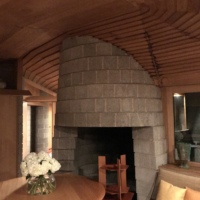
The David Wright House fireplace, the center of the coil. Credit: Steve Sikora
If you were courageous enough to approach Wright for a home, chances are you didn’t expect to be lulled into complacency by the result. Clients had to be both trusting and trustworthy to commit to the whole experience. But what a ride it was! Strapped in and holding on for dear life, Wright’s loyal following enjoyed exhilarating highs and occasionally endured the inevitable disappointments. They embraced the white-knuckled moments when it felt like the roller coaster was about to careen off the rails. For Nancy Willey, the stultifying prospect of evolving into a ceremonial “potted plant,” standing next to Malcolm on a stage was far more terrifying than the thrill ride of working with Wright and committing to his vision full on. It was addictive. Remember, when Nancy Willey was at the Mayo Clinic in Rochester?
She wrote to Wright, “During the first week I wanted to write you and tell you how cheering and splendid a thing your portrait is, when one is away from home, in a hotel room. I have four or five of them around the room and they make me feel not so far from home.” His clients adored him and never wanted the carnival ride to end. Many stood in line for second and even third tickets. Getting it Wright didn’t necessarily mean getting it entirely right either. As reconfirmed in the book Insufficient Funds: The Financial Life of Frank Lloyd Wright, by Peter C. Alexander, his clients, even after doubled construction costs and occasional failings in the infrastructure, almost unanimously adored their resultant homes and could never thank their architect enough for the way these houses changed their lives. If you were fortunate enough to be one of his clients, Wright redefined the fundamental reality of domestic life for you and your family.
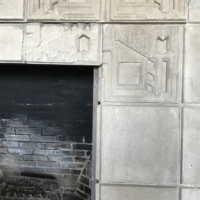
The Freeman House fireplace, is a rare instance of firebrick in one of Wright’s mid-career houses. Credit: Steve Sikora
The remarkable houses he gave them, offered clients a spiritual means, outside of religion, to restore harmony and balance to their lives. Hózhó. The fireplace, central in the architecture of his houses, played a central role in that. And just as Wright said of flowers, fire nourishes the soul.
READ THE REST OF THE SERIES
Part 1: The Open Plan Kitchen
Part 2: Influencing Vernacular Architecture
Part 3: The Inner City Usonian
Part 4: A Bridge Too Far
Part 5: The Best of Clients
Part 6: Little Triggers
Part 7: Step Right Up
Part 8: A Rug Plan
Part 9: Hucksters, Charlatans, and Petty Criminals
Part 10: Lo on the Horizon
Part 11: Origins of Wright’s Cherokee Red
Part 12: One Thousand Words
Part 13: The Plow that Broke the Plains
Part 14: Separated at Birth
Part 15: Trading Drama for Poetry
Part 16: A Red By Any Other Name
Part 17: Roll Down to Levittown
Part 18: Cherokee Red The Rejoinder
Part 19: Nothing Lasts Forever
Part 20: The Struggle
Part 21: Giving What They Had to Give
Part 22: Calling the Kettle Back—Chapter 1: The Kettle
Part 22: Calling the Kettle Back—Chapter 2: The Crane
Part 22: Calling the Kettle Back—Chapter 3: Plagued By Fireplaces
Part 22: Calling the Kettle Back—Chapter 4: A Heritage of Cooking Fires
Part 22: Calling the Kettle Back—Chapter 5: Benefits of the Fireplace
Part 22: Calling the Kettle Back—Chapter 6: Transcendental Flame
Part 22: Calling the Kettle Back—Chapter 7: Repatriation


